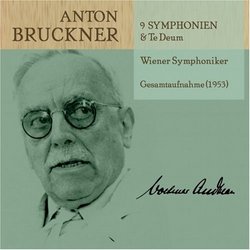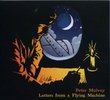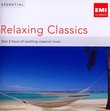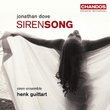| All Artists: Volkmar Andreae Title: Syms 1-9/Te Deum Members Wishing: 0 Total Copies: 0 Label: Music & Arts Release Date: 9/15/2009 Album Type: Box set Genre: Classical Styles: Opera & Classical Vocal, Symphonies Number of Discs: 9 SwapaCD Credits: 9 UPC: 017685122729 |
Search - Volkmar Andreae :: Syms 1-9/Te Deum
 | Volkmar Andreae Syms 1-9/Te Deum Genre: Classical
Although hardly known today, the Swiss conductor Volkmar Andreae (1879-1962) belonged to the great generation of Bruckner conductors born while the composer was still in his prime. This exalted group ranged from Bruno Walt... more » |
Larger Image |
CD DetailsSynopsis
Product Description Although hardly known today, the Swiss conductor Volkmar Andreae (1879-1962) belonged to the great generation of Bruckner conductors born while the composer was still in his prime. This exalted group ranged from Bruno Walter (born 1876) to F. Charles Adler (born 1889), and included such masters as Hermann Abendroth, Wilhelm Furtwängler, Otto Klemperer, Hans Knappertsbusch, and Carl Schuricht. Digital restoration by Aaron Z. Snyder (2009). Notes in German (by Gert Fischer) and English (Mark Kluge). Similar CDs
|
CD ReviewsA scintillating view of Bruckner practice at mid-century Larry VanDeSande | Mason, Michigan United States | 05/15/2010 (5 out of 5 stars) "Switzerland native and conductor Volkmar Andreae (1879-1962) is a largely fogotten man today other than the advocacy of Bruckner enthusiast John Berky, whose Web site dedicated to the composer carried two downloads of Andreae's work. Berky did his best to promote Andreae and this box of the nine numbered symphonies from Anton Bruckner (1824-96) should do more to put Andreae back in the discussion as one the best Bruckner interpreters of the 20th century. Born Berne July 1879 to German-Swiss and Italian parents, the composer-conductor already had a leg up on classical music because of his parents friendship with Johannes Brahms. He trained in Cologne at the end of the 19th century and soon was influenced by Richard Strauss, whom he saw conduct his own music. Andreae was appointed conductor of the Tonhalle Orchestra in Zurich is 1906, beginning a long career as conductor and Bruckner specialist. He gave the Swiss premieres of Bruckner's Symphonies Nos. 4 and 9 in 1909 and 1907, respectively, and had conducted all nine numbered symphonies by 1911. He organized a Bruckner festival in Zurich in 1936 and by the time of these recordings had conducted some of the symphonies 40 times. These recordings were taped by Austrian radio in 1953 and represent Andreae's mature style with the composer. Like many of his era, Andreae did not like studio recordings and chose to record in concert and radio. His conducting style represents the freer, more flexible pacing and articulation that was dominant before the advent of the postwar literalist style. Influential postwar conductors including Herbert von Karajan Bruckner: 9 Symphonies [Box Set] and Gunther Wand Bruckner: Symphonies Nos. 1 - 9 [Germany] helped change this tide, using more strict rhythm and pacing to the point that today's authenticists use nearly metronomic time. Only Eugen Jochum among postwar Bruckner specialists Symphonies 1-9 and, to lesser extent, Daniel Barenboim Bruckner: The Nine Symphonies; Helgoland [Box Set] were of a similar mindset when it came to interpreting Bruckner's scores. This flexibility bordering on rubato was Andreae's signature and you hear it throughout this set. Some of the more notable interpretive devices include rushing allegros that die off to slow moments, ritards during finales and in codas, and a singing line that often speeds up as the music becomes more emotional. This set is dotted with these affectations; here are a few instances of the magic Andreae weaves into Bruckner: -- A magical duet for strings near the end of Symphony 2's andante that dies off to utter peace. -- The Symphony No. 3 is perhaps the opus most affected by Andreae's rising and declining tides of speed, pace and movement. He caps this by taking a gigantic slowdown at the coda in the finale, one of the most extraordinary moments in the set, helping the Third Symphony stand out. -- The "Romantic" Fourth Symphony is also dotted with regular rhythmic alterations. -- The end of the Symphony No. 6's first movement has a pronounced ritard. -- In the andante of Symphony No. 7 you can hear some good old string portamento. The symphonies come one to a disk. The Te Deum is linked to Symphony 9 and is given a granitic reading strong on mystery and profundity as opposed to power or devotion with an outstanding singing quartet. Andreae, whom the notes say dedicated his life to Bruckner, was practial about editions, using those that were popular in the time. Of the recordings in this box, Symphonies 1 (Linz version), 2, 4, 5 and 7 used the Haas editions from the 1930s. The Symphonies 3 (Rattig), 6, 8 and 9 (Orel) use the first printed editions of the scores while No. 7 uses an edition from Guttman. None of these versions are goiing to sound much different than others you've heard unless your only Bruckner exposure has been through the modern day authenticists that use Bruckner's original editions. Bruckner's symphonies get a new edit about every 30 years; editors inlcude Robert Haas in the 1930s, Leopold Nowak in the 1950s, and William Carragan in the 1990s. The sound on this set, taken from several Austrain radio sources, is always good and often fabulous sans wow, flutter and distortion. The popular Symphonies 4 and 8 are recordings of such high quality you'd look twice to note they were sourced from 1953, more than a half-century ago. Arts and Music has done yeoman's work translating and restoring the orignal tapes. The symphonies come one per CD with the Te Deum mated to the Symphony No. 9. It's not possible to find a Bruckner set without drawbacks and this one has them too. The Vienna string sound is often wiry and sometimes thin and the conductor sometimes ends a symphony abruptly. There is occasional out of tune playing and Arts and Music has packaged this set in a box with individual sleeves for each CD, making it almost impossible not to touch the playing surface when you remove the CD from the envelope. At the end of Symphony 9, the important ascending horn notes that signify the end of Bruckner's life are not ideally clear. These few debits do little to dampen my enthusiasm for this outstanding set. If you love Bruckner and do not know the musicmaking of Volkmar Andreae, you should find out about him as soon as you can. With a price bordering on $100 (but much less through Amazon vendors), this set is expensive. In my opinion, it is worth it. I listened to this straight through the first time and found a bit of Bruckner fatigue setting in. But, each time I thought an interpretation was becoming less than sterling, Andreae and the Austrian recording engineers would show me something outstanding. A wonderful booklet in four languages that's full of pictures, history, biographical information and documentation of the music and recordings is the cherry on top. Plaudits are due Arts and Music for giving collectors another classic set of Bruckner symphonies to go along with Furtwangler's six pack Furtwangler Conducts Bruckner: Symphonies 4,5,6,7,8,9 from a couple years ago. This is one of the best recordings I've bought this year." Terrific cycle Prunehead Guru | Boston, USA | 07/14/2010 (5 out of 5 stars) "This is one of the best Bruckner symphony cycles out there, and I have heard just about all of them. Everything is paced in a manner that this feels like "natural" Bruckner. Fantasic performances, all of them. Bruckner lovers need not hesitate over the recorded sound either, which is first rate mid-1950s mono remastered to perfection."
|

 Track Listings (4) - Disc #1
Track Listings (4) - Disc #1



